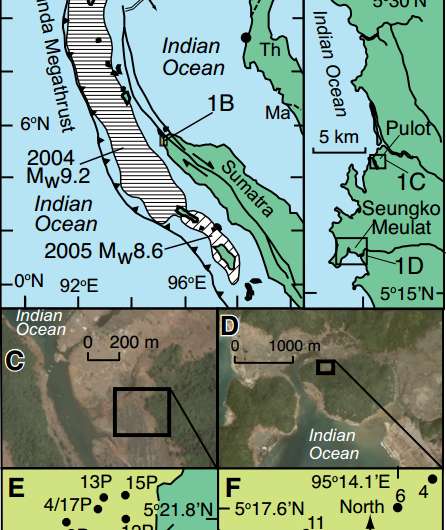Understanding subduction zone earthquakes

The 26 December 2004 Mw ~9.2 Indian Ocean earthquake (also known as the Sumatra-Andaman or Aceh-Andaman earthquake), which generated massive, destructive tsunamis, especially along the Aceh coast of northern Sumatra, Indonesia, clearly demonstrated the need for a better understanding of how frequently subduction zone earthquakes and tsunamis occur. Toward that end, Harvey M. Kelsey of Humboldt State University and colleagues present a study of earthquake history in the area.
Using subsidence stratigraphy, the team traced the different modes of coastal sedimentation over the course of time in the eastern Indian Ocean where relative sea-level change evolved from rapidly rising to static from 8,000 years ago to the present day.
Kelsey and colleagues discovered that 3,800 to 7,500 years ago, while sea level was gradually rising, there were seven subduction zone earthquakes recorded in coastal deposits. This was determined in part by the fact that each earthquake caused burial of a mangrove soil by sediment and/or deposition of tsunami sand at the time of the earthquake.
The team also discovered that sea level gradually stopped rising about 3,800 years ago, which meant that buried soils no longer formed. Thus, detecting subduction zone earthquakes required a different approach. They found a record of successive earthquakes in a sequence of stacked tsunami deposits on the coastal plain. Individual tsunami deposits were 0.2 to 0.5 m thick. Based on this information, Kelsey and colleagues determined that in the past 3,800 years there were between four and six tsunamis caused by Andaman-Aceh-type earthquakes.
The authors conclude that knowing the relative sea-level record for a coastal region on a subduction zone margin is the initial step in investigating paleoseismic history. For mid-latitude coasts that border subduction zones, sequences of buried soils may provide a long-duration, subsidence stratigraphic paleoseismic record that spans to the present, but in other settings such as the Aceh coastal plain, joint research approaches, for example targeted foraminiferal analyses and palynology, are required to both exploit the changing form of the relative sea-level curve and characterize coastal evolution in the context of the diminishing importance of accommodation space.
More information: "Accommodation space, relative sea level, and the archiving of paleo-earthquakes along subduction zones." Geology, G36706.1, first published on June 23, 2015, DOI: 10.1130/G36706.1
Journal information: Geology
Provided by Geological Society of America
















